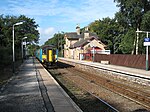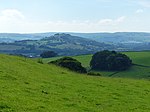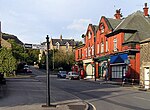Combs, Derbyshire

Combs is a small village in Derbyshire, England, in the civil parish of Chapel-en-le-Frith and the Peak District National Park. The village is bounded to the east, west and south by gritstone edges and moorland, the highest of which is Black Edge (507 m (1,663 ft)). To the north the embankment of the Buxton to Stockport railway separates it from Combs Reservoir. To the east is Castle Naze, a prehistoric settlement site. The village has a pub, the Beehive Inn, and infant school.Combs resident Herbert Frood developed a vehicle brake pad and in 1897 founded the company Ferodo. The village was also home to journalists and authors Crichton Porteous and Peggy Bellhouse. Old Brook House and its barn, close to the Beehive public house, is a listed building. Parts of it dates from the 17th and 18th centuries, as does Marsh Hall closer to Chapel-en-le-frith.
Excerpt from the Wikipedia article Combs, Derbyshire (License: CC BY-SA 3.0, Authors, Images).Combs, Derbyshire
Combs Road, High Peak Chapel-en-le-Frith
Geographical coordinates (GPS) Address Nearby Places Show on map
Geographical coordinates (GPS)
| Latitude | Longitude |
|---|---|
| N 53.3051 ° | E -1.937 ° |
Address
Combs Road
Combs Road
SK23 9UP High Peak, Chapel-en-le-Frith
England, United Kingdom
Open on Google Maps











